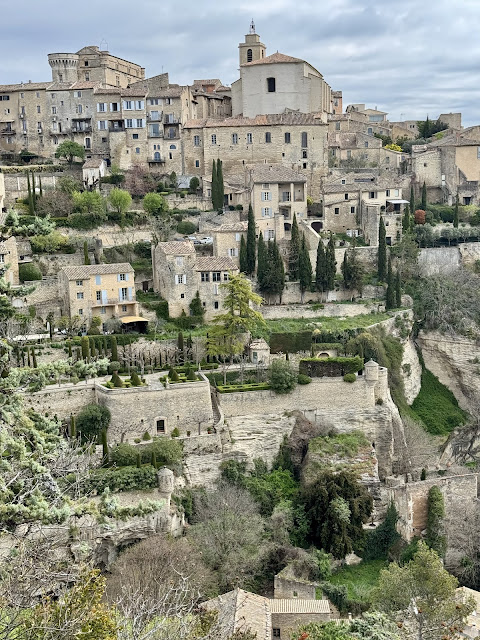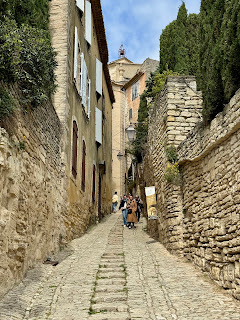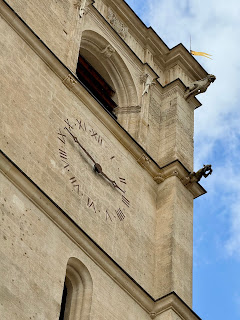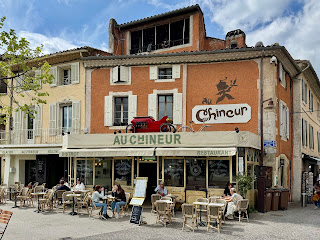After an unexpected conversation with the gregarious proprietor of C'est la Vie (Salem), we have three options for today's itinerary:
- to the west, the Roman archaeology in Pont du Gard (l'aqueduc) and Nîmes (les arènes);
- to the south, the art of Vincent van Gogh in Saint-Rémy-de-Provence and the ruins of Le Château in Les Baux-de-Provence; and
- to the east the picturesque villages of Gordes and L'Isle-sur-la-Sorgue.
Since this our last full day in Provence and our first French roadtrip, we decide to put archaeology and art aside, and drink-in the French countryside.
So, Gordes (pop 1,664 in 2022) is our first stop, "the most beautiful village in the world"; actually, our first stop is the point de vue on the opposite hillside. Even with expectations set high, Gordes does not disappoint. The village emerges from a rocky escarpment; the buildings and the hillside are hardly distinguishable. Within a vivid valley and the looming backdrop of grey mountains, it is a burst of honey-colored stone and cypress tree. As we walk along the roadside, the buildings slowly turn and face us.
We drive on another five minutes to the north side of the ridge, where there is plenty of tourist parking. After a short walk we arrive at the Château de Gordes (11th-16th centuries), with its striking rounded tower and corner turrets; it is longer and more imposing than our initial 'end-on' view suggests.
On the north side is the Place du Château, the de-facto town center, with shops, cafes, and restaurants. But the Château's views are to the south, where a raised terrace faces a narrow, pedestrian lane, which drops to the front of the church.
The facade of the Eglise Saint-Firmin (rebuilt, 18th century) could not be plainer, with just a hint of geometry. But the interior is full of color and pattern, the sandy earth-tones and sky-blues play against each other as if taken from the outside and re-applied.
On the left side of the nave, La Crucifixion catches our eye. We note some of the sculpture is free-standing, while some is in grisaille, embellished with trompe-l'œil moldings and tracery.
The steep church entrance blends into a stepped road, the Rue du Belvédère, which dives downhill, and turns east. Along the wall, the road offers an unobstructed panorama of the valley and the Montagne du Lubéron.
The labyrinth of stepped roads invites us west, and we circle behind the church and stare back to the point de vue where we started. We are fully immersed, Escher-like figures in a landscape that we both observe and inhabit.
L'Isle-sur-la-Sorgue (pop 20,315 in 2022) is halfway from Gordes to Avignon, and so the perfect lunch stop. We drive around the island village, and park on the north side, where again, the thoughtful French townsfolk furnish tourists with ample parking. This appears to be another island, with canals on either side and a tiny footbridge leading into town.
This town is famous for its canals as well as Les Roues à Aubes (paddle wheels). Our footbridge is near La Roue du Portalet (Roue de la Filature a Soie Goudard, 20th century), a lovely welcome for the 'parking island'. The clear water is flowing at a good clip, raking the grasses downstream (west).
As we wander through the little backstreets, there are ruddy reds, flashes of pink, and the consistent earthy-green of the doors and shutters. Turning a corner, the alley opens into the Place de L'Église, where the traffic of service vans mixes with the tall, budding trees.
The stacked temple-front and Le Clocher of L'Église Notre-Dame-des-Anges (17th century) tower over the square. Several of the eateries lining the Place offer relaxing shade and aromatic food, under the gaze of the church's gargoyles.
After a wonderful meal, we walk south, through the shops of the Rue de la République. This ends, unsurprisingly, at another canal; here, the Caisse d'Epargne (La Château Dumas, 19th century) straddles two channels as they converge and pick up both sound and speed, as illustrated by the lazy, but clever ducks whizzing by.
We cross the south canal to inspect the eclectic merchandise on offer at the Galerie Demesure: lacey donkeys, Betty Boop(s), garden gates and decorations, Robert Indiana's iconic LOVE, etc. Small tables and wickers chairs line the opposite bank, with iron railings and awnings all under the branches of the mature trees – a bucolic image of country living.
A tiny park sits low on the canal near the Place René Char, a kind of wide bridge that's also a roundabout. The park is a showcase for the Roue à Aube de la Porte d'Avignon (originally 16th century), with small gates, steppingstones, a thin arched-bridge, and the splash of the clear waters.
Crossing back into the L'Isle, we make our way around the larger, partially abandoned buildings of La Maison de Charité (17th century).
We re-emerge where the canals complete their circuit and reform La Sorgue. There are a pair of paddle wheels, the Roue des Tourelles (19th century) and the Roue de Valébrègue (part of the Brun de Vian-Tiran factory, 18th century).
The water looks quite high under the bridge arches of the Cours Victor Hugo (18th century), with the added drama of whitewater from the swirl and churn of the clashing flows. Just above, an old manor house, Le Château Giraud (19th century), stands shuttered.
We decide to take a quick tour of the neighboring Musée-boutique La Filaventure Brun de Vian-Tiran (18th century).
Assuming we'd see the rusty machinery of a wool mill connected to the old wheel, we instead find ourselves in the signature showroom of Brun de Vian-Tiran (online store), with opulent displays of brightly colored and boldly patterned blankets, throws, shawls, and scarves in wool and mohair.
With that shock of expectation, we climb the stairs and enter the Le Musée 'Sensoriel'. We leave the French idyll behind and enter an interactive techno-world, with moody lights, and immaculately draped fabrics.
The first room contains models of exotic animals, and samples of fibers. This lifts L'Isle to a higher status, the center of global trade. Other rooms explain the company's innovative manufacturing processes, and how the fibers are combed and softened.
Back outside, village life carries on. We follow the north canal past three more wheels: Roue des Lices de Villevieille (three-section wheel, 19th century), Roue des Minimes (17th century), and Roue du Quai Nord.
To end our day in the French countryside, in the parking lot near our rental, we find a well-used and well-loved Citroën 2CV (late 1960's – round lights, front-hinged doors, rear quarter windows). We can think of no better denouement.




















































































No comments:
Post a Comment